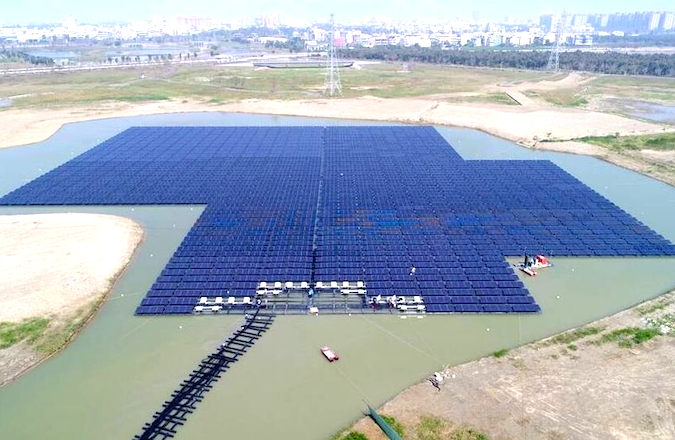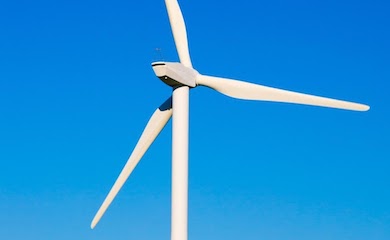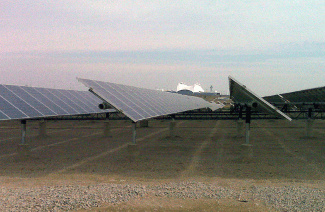Humanity has come very far in its efforts for renewable energy in recent years. From using wind turbines to harness the power of the breeze, to angling solar panels to soak up the sun’s rays, and even turning discarded French fries into biofuel – we have certainly had some bright ideas. But just when it seemed like we had reached our limit, a technique emerged that takes renewable energy to a new level. Enter floatovoltaics: the concept of making solar panels float in water. Turns out, as far as drawing power from the sun is concerned, land is so last century. Pager Power previously discussed the topic here.
Figure 1: Floating solar photovoltaic panels.
Floatovoltaics or floating solar photovoltaic panels (FPV) are solar panels that are installed on water bodies such as lakes, reservoirs, and even seas. They not only harness solar energy but also shield the water from the sun and reduce evaporation.
Traditional solar farms are often criticised for occupying a huge amount of land [1]. Approximately six acres of land are needed for every megawatt (MW) of power generated, making them advantageous for countries with limited available land and high land costs.
A recent study from Bangor and Lancaster Universities and the UK Centre for Ecology & Hydrology has revealed the daily electrical output of FPV on nearly 68,000 lakes and reservoirs around the world by using available climate data for each location. The selected water bodies were not protected, located no more than 10km from the nearest populous area, or chosen in a way that they did not dry or freeze up for more than six months. The output was calculated by using just conservative surface area coverage of 10% up to a maximum of 30 km2 [2].
The researchers calculated a whopping 14,906 Terawatt hours (TWh) theoretical global output across 1 million water bodies for 1 kilowatt (kW) FPV. The annual power output fluctuated depending on the region’s different geographical variations and factors such as latitude, altitude, and season. The resulting potential output was around 1,302 TWh from 67,893 water bodies (94% of studied water bodies were considered unsuited due to research constraints) [3].
It was estimated that FVPs in the UK could annually produce 2.718 TWh, which is 0.825% of the overall electricity demand. FPVs could potentially reduce 621,871.777 tonnes of CO2, thereby aiding in decarbonising the economy.
“We still don’t know exactly how floating panels might affect the ecosystem within a natural lake, in different conditions and locations. But the potential gain in energy generation from FPV is clear,” said Dr Iestyn Woolway of Bangor University, the lead author of the paper.
The UK has very few FPV installations currently, the largest one being the Queen Elizabeth II reservoir near London with a capacity of 6.3MW [4]. The UK has currently about 14 gigawatts (GW) of solar capacity and is expected to grow five times by 2035 [5].
Studies have also shown that FVPs are 0.1-4.5% more energy efficient and predicted to generate 0.6-4.4% more energy than their land counterparts [6]. It was calculated that for every 1-degree rise in temperature, there was a voltage drop of 0.12V [7]. Water bodies provide a cooling effect, reducing the operating temperature of solar panels and thereby increasing their efficiency. FPVs also limit the amount of sunlight penetrating the water. Thus, controlling algae growth in water and improving the aquatic ecosystems [8]. FPVs have also emerged as a potential solution to reduce water scarcity. It was found that the evaporation rate of the water bodies across many parts of the world was reduced due to the addition of FVPs [9], [10], [11], [12].
Floatovoltaics are more than a clever pun, they put sustainability into practice by maximising land use and enhancing performance. In light of the recent shift towards renewable energy sources, floatovoltaics can contribute greatly to world energy needs by harnessing power while preserving precious land and water.
Pager Power
Pager Power undertakes technical assessments for developers of renewable energy projects and tall buildings worldwide. For more information about what we do, please get in touch.
References
[1] C. B. Staff, ‘Factcheck: Is solar power a “threat” to UK farmland?’, Carbon Brief. Accessed: Jun. 14, 2024. [Online]. Available: https://www.carbonbrief.org/factcheck-is-solar-power-a-threat-to-uk-farmland/
[2] ‘Some countries could meet their total electricity needs from floating solar panels, research shows’, Bangor University. Accessed: Jun. 14, 2024. [Online]. Available: https://www.bangor.ac.uk/news/2024-06-04-some-countries-could-meet-their-total-electricity-needs-from-floating-solar-panels
[3] R. I. Woolway, G. Zhao, S. M. G. Rocha, S. J. Thackeray, and A. Armstrong, ‘Decarbonisation potential of floating solar photovoltaics on lakes worldwide’, Nat. Water, pp. 1–11, Jun. 2024, doi: 10.1038/s44221-024-00251-4.
[4] ‘Queen Elizabeth II Reservoir solar | Lightsource bp UK’. Accessed: Jun. 14, 2024. [Online]. Available: https://lightsourcebp.com/project/queen-elizabeth-ii-reservoir-solar/
[5] ‘Major acceleration of homegrown power in Britain’s plan for greater energy independence’, GOV.UK. Accessed: Jun. 14, 2024. [Online]. Available: https://www.gov.uk/government/news/major-acceleration-of-homegrown-power-in-britains-plan-for-greater-energy-independence
[6] R. C J, K. H. Lim, J. Kurnia, S. Roy, B. Bora, and B. Medhi, ‘Towards sustainable power generation: Recent advancements in floating photovoltaic technologies’, Renew. Sustain. Energy Rev., vol. 194, p. 114322, Apr. 2024, doi: 10.1016/j.rser.2024.114322.
[7] ‘Review of cooling techniques used to enhance the efficiency of photovoltaic power systems | Environmental Science and Pollution Research’. Accessed: Jun. 14, 2024. [Online]. Available: https://link.springer.com/article/10.1007/s11356-022-18719-9
[8] 4dwebdesign, ‘Floating Solar: A Sustainable Boost for Aquatic Environments’, Ecoaim. Accessed: Jun. 14, 2024. [Online]. Available: https://ecoaim.co.uk/floating-solar-a-sustainable-boost-for-aquatic-environments/
[9] L. C. A. da Costa and G. D. P. da Silva, ‘Save water and energy: A techno-economic analysis of a floating solar photovoltaic system to power a water integration project in the Brazilian semiarid’, Int. J. Energy Res., vol. 45, no. 12, pp. 17924–17941, 2021, doi: 10.1002/er.6932.
[10] M. Padilha Campos Lopes, S. de Andrade Neto, D. Alves Castelo Branco, M. A. Vasconcelos de Freitas, and N. da Silva Fidelis, ‘Water-energy nexus: Floating photovoltaic systems promoting water security and energy generation in the semiarid region of Brazil’, J. Clean. Prod., vol. 273, p. 122010, Nov. 2020, doi: 10.1016/j.jclepro.2020.122010.
[11] K. K. Agrawal, S. K. Jha, R. K. Mittal, and S. Vashishtha, ‘Assessment of floating solar PV (FSPV) potential and water conservation: Case study on Rajghat Dam in Uttar Pradesh, India’, Energy Sustain. Dev., vol. 66, pp. 287–295, Feb. 2022, doi: 10.1016/j.esd.2021.12.007.
[12] É. Ferraz de Campos, E. B. Pereira, P. van Oel, F. R. Martins, A. R. Gonçalves, and R. S. Costa, ‘Hybrid power generation for increasing water and energy securities during drought: Exploring local and regional effects in a semi-arid basin’, J. Environ. Manage., vol. 294, p. 112989, Sep. 2021, doi: 10.1016/j.jenvman.2021.112989.
Image credit; 高雄市政府水利局, Attribution, via Wikimedia Commons. Last accessed on 17th June 2024.




